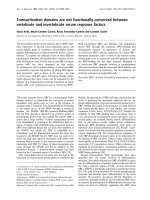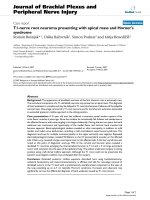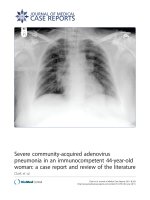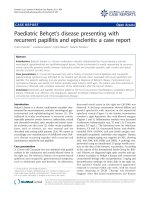Báo cáo y học: " Severe refractory autoimmune hemolytic anemia with both warm and cold autoantibodies that responded completely to a single cycle of rituximab: a case report" pps
Bạn đang xem bản rút gọn của tài liệu. Xem và tải ngay bản đầy đủ của tài liệu tại đây (301.48 KB, 5 trang )
CAS E REP O R T Open Access
Severe refractory autoimmune hemolytic anemia
with both warm and cold autoantibodies that
responded completely to a single cycle of
rituximab: a case report
Shilpi Gupta
1*
, Anita Szerszen
2
, Fadi Nakhl
1
, Seema Varma
1
, Aaron Gottesman
3
, Frank Forte
1
and Meekoo Dhar
1
Abstract
Introduction: Mixed warm and cold autoimmune hemolytic anemia runs a chronic course with severe intermittent
exacerbations. Therapeutic opt ions for the treatment of hemolysis associated with autoimmune hemolytic anemia
are limited. There have been only two reported cases of the effective use of rituximab in the treatment of patients
with mixed autoimmune hemolytic anemia. We report a case of severe mixed autoimmune hemolytic anemia that
did not respond to steroids and responded to four weekly doses of rituximab (one cycle).
Case presentation: A 62-year-old Caucasian man presented with dyspnea, jaundice and splenomegaly. His blood
work revealed severe anemia (hemoglobin, 4.9 g/dL) with biochemi cal evidence of hemolysis. Exposure to cold led
to worsening of the patient’s hemolysis and hemoglobinuria. A direct antiglobulin test was positive for
immunoglobulin G and complement C3d, and cold agglutinins of immunoglobulin M type were detected. A bone
marrow biopsy revealed erythroid hyperplasia. A positron emission tomographic scan showed no sites of
pathologic uptake. There was no other evidence of a lymphoid or myeloid disorder. Initial therapy consisted of
avoidance of cold, intravenous methylprednisolone and a trial of plasmapheresis. However, there was no clinically
significant response, and the patient continued to be transfusion-dependent. He was then started on 375 mg/m
2
/
week intravenous rituximab therapy. After two treatments, his hemoglobin stabilized and the transfusion
requirement diminished. Rituximab was continued for a total of four weeks and led to the complete resolution of
his hemolytic anemia and associated symptoms. At the patient’s last visit, about two years after the initial rituximab
treatment, he continued to be in complete remission.
Conclusion: To the best of our knowledge, this is the first reported case of mixed-type autoimmune hemolytic
anemia that did not respond to steroid therapy but responded completely to only one cycle of rituximab. The
previous two reports of rituximab use in mixed autoimmune hemolytic anemia described an initial brief response
to steroids and the use of rituximab at the time of relapse. In both of these case reports, the response to one cycle
of rituximab was short-lived and a second cycle of rituximab was required. Our case report demonstrates that
severe hemolysis associated with mixed autoimmune hemolytic anemia can be unresponsive to steroid therapy
and that a single cycle of rituximab may lead to prompt and durable complete remission.
* Correspondence:
1
Department of Medicine (Hematology and Medical Oncology), Staten Island
University Hospital, 256 C Mason Avenue, Staten Island, NY 10305, USA
Full list of author information is available at the end of the article
Gupta et al. Journal of Medical Case Reports 2011, 5:156
/>JOURNAL OF MEDICAL
CASE REPORTS
© 2011 Gupta et al; licensee BioMed Centr al Ltd. This is an Open Access article distributed under the terms of the Creative Commons
Attribution License (http://crea tivecommons.org/licenses/by/2.0), which pe rmits unrestricted use, distribution, and re prod uction in
any medium, provide d the origin al work is properly cited.
Introduction
Autoimmune hemolytic anemia (AIHA) is one of the
most common causes of acquired hemolytic anemia.
The cause of AIHA r emains idiopathic in 50% of the
cases [1]. The clinical presentation of AIHA depends on
the subclass type: warm agglutinin, cold agglutinin and
mixed disorder, as well as the thermal range activity of
the causative autoantibody.
Mixed warm and cold AIHA runs a chronic course
with severe intermittent exacerbations. Therapeutic
options for the treatment of hemolysis associated with
mixed AIHA are limited.
Therapeutic options for patients with AIHA i nclude
treatment of the underlying etiology, such as a lympho-
proliferative disorder if diagnosed, or the use of cyto-
toxic agents such as cyclophosphamide, cyclosporine,
chlorambucil or corticosteroids. Additionally, plasma-
pheresis can be used for the removal of causative anti-
bodies and to slow down the rate of hemolysis.
Splenectomy has been employed in patients with warm
autoimmune hemolytic disease to slow down the hemo-
lysis. Recently, reports of the use of rituximab for initial
and recurrent cases of AIHA have shown an objective
response, with more than 50% of patients experiencing
complete remission [2]. We have utilized this treatment
with promising results.
Case presentation
A 62-year-old Caucasian m an with a history of chronic
alcohol abuse presented to the emergency department
with complaints of shortness of b reath and confusion of
three days’ duration. The patient’s vital signs were stable
except for sinus tachycardia of 110 beats/min. The
patient was confused, lethargic and pale. His physical
examination was remarkable for scleral icterus, shifting
dullness, hepatosplenomegaly and bilateral lower-extre-
mity pitting edema. There was no significant peripheral
lymphadenopathy, and there was no evidence of
hypertension.
The complete blood count revealed anemia with a
hemoglobin level of 4.5 g/dL, a reticulocyte count of
25.82% and normal w hite cell and platelet counts.
Hemolysis was confirmed by elevated lactate dehydro-
genase (LDH) of 447 U/L and low h aptoglobin of 9.18
mg/dL. Red blood cell agglutination, polychromasia, tar-
get cells and spherocytes were seen on a peripheral
smear. The direct Coombs test was positive for comple-
ment C3d and immunoglobulin G (IgG) antibody, which
were identified as anti-I cold agglutinins at 4°C.
The diagnosis of re nal insufficiency was made on the
basis of the patient’ s glomerular filtration rate of 40.84
mL/min/1.73 m
2
(creatinine level of 2 mg/dL). His liver
function tests were significant for an elevated total
bilirubin level of 5.3 mg/dL, a direct bilirubin level of
1.8 mg/dL and an ammonia level of 136 μM/L. His
albumin and total protein levels were 3.1 g/dL and 7 g,
respectively. The patient’ s hepatitis profile was negat ive,
and no cryoglobulinemia was observed.
Although our patient did not have gastrointestinal
bleeding or hematuria, his urine was reported to be dark
on several occasions, which was precipitated by expo-
sure to cold. Additionally, marked drops in hemoglobin
and haptoglobin levels were noted after exposure to
cold. Proteinuria on urine analysis prompted a 24-hour
urine collection, which was significant for nephrotic
range proteinuria of 15 g/day. Serum whole complement
activity (CH50) level was reduced with normal comple-
ment C3 and C4 levels. No monoclonal spike was
observed in serum or urine electrophoresis.
Mycoplasma pneumoniae infection, infectious mono-
nucleosis, systemic lupus ery thematosus and human
immunodeficiency virus were ruled out. Computed
tomography (CT) of the chest, abdomen and pelvis was
remarkable for hepatosplenomegaly. Subsequently, the
patient underwent a bone marrow biopsy that showed a
hypercellular marrow with erythroid hyperplasia, but no
evidence of dysplasia or lymphoma. A liver biopsy
revealed stage IV fibrosis with no evidence of malig-
nancy. This finding was thought to be secondary to the
history of alcohol abuse.
During the hospital course, the patient underwent
transfusion with several units of incompletely matched
packed red blood cells through a warmer and was
started on i ntravenous methylprednisolone therapy. In
spite of corticosteroid therapy, the patient’s hemoglobin
did not improve, and he continued to require blood
transfusions almost daily. Consequently, a daily regimen
of plasmapheresis was initiated.
Partial resolution of the hemolytic process was
observed while the patien t was treated with daily plas-
mapheresis with 5% albumin, at a volume of 3L to 4L.
A total of seven daily plasmapheresis treatments were
performed, which resulted in a gradual decrease of the
patient’ s LDH and bilirubin and a rise in his level of
haptoglobin. However, the patient still required almost
daily blood transfusions. On the basis of earlier reports
indicating an anecdotal benefit of rituximab treatment
for immune cytopenias, plasmapheresis was discontin-
ued and our patient was placed on rituximab therap y at
adoseof375mg/m
2
every week. A total of four doses
were administered over a period of four weeks.
Although an initial increase in LDH level after the
initiation of rit uximab treatment was noted, there was
no evidence of worsening hemolysis. After the first two
courses of rituximab therapy, the patient showed a
marked clinical improvement. His hemoglobin level
Gupta et al. Journal of Medical Case Reports 2011, 5:156
/>Page 2 of 5
stabilized (Figure 1, Figure 2 and Figure 3), and he no
longer required blood transfusions.
Sub sequently, he was discha rged to home with contin-
ued follow-up as an outpatient. He was also started on b-
blockers and calcium channel blockers for high blood
pressure at the time of discharge. During outpatient
follow-up, the patie nt’s proteinuria level decreased from
15 g per 24 hours to 5.5 g per 24 hours. A renal biopsy
was performed and demonstrated nodular glomerulo-
sclerosis with no evidence of immune complex deposi-
tion. At his two-year follow-up examination after the
initial rituximab therapy, the patient continued to be
Figure 1 Effect of treatment on serum lactate dehydrogenase.
Figure 2 Effect of treatment on reticulocyte count.
Gupta et al. Journal of Medical Case Reports 2011, 5:156
/>Page 3 of 5
transfusion-independent and his last hemoglobin level
was 12.5 g /dL. Another renal biopsy was performed and
demonstrated nodular mesangial widening with increased
matrix and tubular basement membrane thickening with-
out deposits visualized on light microscopy. On the basis
of the findings of light and electron microscopy and
immunopathology, a diagnosis of nodular glomerulo-
sclerosis with no evidence of immune complex deposi-
tion was made. These changes can be seen in patients
with diabetes or even in healthy indiv iduals. At his two-
year follow-up examination after the initial rituximab
therapy, the patient continued to be transfusion-indepen-
dent and his last hemoglobin level re ading was 12.5 g/dL.
His hospital course was complicated by the development
of steroid-induced diabetes mellitus, warranting insulin
use during his hospitalization. His diabetes resolved after
the discontinuation of steroids.
Discussion
On the basis of the clinical presentation and laboratory
analysis, our patient was diagnosed with mixed AIHA.
Concomitant features of liver dysfunction and nephrotic
syndrome secondary to nodular glomerulosclerosis were
also seen. Reticuloendothelial involvement led to an
extensive workup t hat ruled out an infectious or lym-
phoproliferative etiology of this clinical presentation.
Rituximab is a anti-CD20 monoclonal antibody that
has been used in the management of patients with cold
agglutinin disease with severe hemolysis not responding
to treatment with conventional therapy. In an uncon-
trolled prospective study, 14 of 27 patients with cold
agglutinin disease, 15 of whom had been previously trea-
ted, responded to a single course of rituximab, and six
of 10 responded to retreatment with rituximab and
interferon [2]. In another study, rituximab was used to
treat immune cytopenia in adults, and 40% of the
patients with AIHA showed complete remission [3]. The
use of rituximab in a small prospective study of eight
patients with nephrotic syndrome due to idiopathic
membranous nephropathy l ed to sustained disease
remission [4].
In view of the limited response to conventional ther-
apy with corticosteroids and plasmapheresis, rituximab
therapy was initiated, which led to rapid improvement
in our patient and marked improvement in the hemoly-
tic process. His hemoglobin level stabilized, and he did
not require blood transfusion after rituximab therapy.
His prote inuria was reduced by more than 50%, and his
edema almost completely resolved. The nodular glomer-
ulosclerosis noted on the patient’s renal biopsy may
have been idiopathic or seco ndary to diabetic nephropa-
thy, immunotactoid glomerulonephritis, fibrillary
Figure 3 Effect of treatment on hemoglobin levels.
Gupta et al. Journal of Medical Case Reports 2011, 5:156
/>Page 4 of 5
glomerulonephritis, cryoglobulinemic glomerulonephri-
tis, amyloidosis, light-chain deposition disease or heavy-
chain deposition disease. The cause is unclear; howeve r,
the autoimmune disorder that caused the AIHA might
also have been a precipitating factor for the renal
findings.
Rituximab has been shown to be effective in the treat-
ment of viral infection-associated nephropathy in con-
junction with antiviral therapy. Ohsawa et al. [5] reported
the case of a patient with cryoglobulinemia and hepatitis
C virus infection. Their patient had warm antibody-
mediated AIHA with immune complex nephropathy.
To our knowledge, our case is the first reported pre-
sentation of mixed AIHA that did not resp ond to ster-
oids but showed a complete and sustained response to
rituximab. Two previous reports of rituximab use in
mixed AIHA described an initial brief response to ster-
oids. Rituximab was begun at the time of relapse. In
both cases, the response to four weekly injections of
rituximab was short-lived and required a second cycle
[6,7].
Conclusion
This is the first reported case of a pa tient with mixed-
type AIHA who did not respond to steroid therapy but
showed a complete response to only one cycle of rituxi-
mab. Refractory AIHA is a difficult condition to man-
age, and novel therapeutic agents such as rituximab
merit further investigation in this setting.
Consent
Written informed consent was obtained from the patient
for publication of this case report and any accompany-
ing images. A cop y of the written consent is available
for review by the Editor-in-Chief of this journal.
Conflict of interests
The authors declare that they have no competing
interests.
Author details
1
Department of Medicine (Hematology and Medical Oncology), Staten Island
University Hospital, 256 C Mason Avenue, Staten Island, NY 10305, USA.
2
Department of Medicine (Geriatrics), Staten Island Universi ty Hospital, 475
Seaview Avenue, Staten Island, NY 10305, USA.
3
Department of Medicine
(Hospitalist Medicine), Staten Island University Hospital, 475 Seaview Avenue,
Staten Island, NY 10305, USA.
Authors’ contributions
SG wrote the manuscript. AS performed the literature search and helped
with writing the manuscript. FN performed the literature search and all
procedures required for the patient. SV constructed all the figures in the
manuscript. AG performed the literature search. FF was a major contributor
in the writing of the manuscript. MD was the treating physician of the
patient. All authors read and approved the final manuscript.
Received: 8 April 2010 Accepted: 19 April 2011 Published: 19 April 2011
References
1. Rochant H: [Autoimmune hemolytic anemia] [in French]. Rev Prat 2001,
51:1534-1541.
2. Berentsen S, Ulvestad E, Gjertsen BT, Hjorth-Hansen H, Langholm R,
Knutsen H, Ghanima W, Shammas FV, Tjønnfjord GE: Rituximab for primary
chronic cold agglutinin disease: a prospective study of 37 courses of
therapy in 27 patients. Blood 2004, 103:2925-2928.
3. Shanafelt TD, Madueme HL, Wolf RC, Tefferi A: Rituximab for immune
cytopenia in adults: idiopathic thrombocytopenic purpura, autoimmune
hemolytic anemia, and Evans syndrome. Mayo Clin Proc 2003,
78:1340-1346.
4. Ruggenenti P, Chiurchiu C, Brusegan V, Abbate M, Perna A, Filippi C,
Remuzzi G: Rituximab in idiopathic membranous nephropathy: a one-
year prospective study. J Am Soc Nephrol 2003, 14:1851-1857.
5. Ohsawa I, Uehara Y, Hashimoto S, Endo M, Fujita T, Ohi H: Autoimmune
hemolytic anemia occurred prior to evident nephropathy in a patient
with chronic hepatitis C virus infection: case report. BMC Nephrol 2003,
4:7.
6. Morselli M, Luppi M, Potenza L, Tonelli S, Dini D, Leonardi G, Donelli A,
Narni F, Torelli G: Mixed warm and cold autoimmune hemolytic anemia:
complete recovery after 2 courses of rituximab treatment. Blood 2002,
99:3478-3479.
7. Webster D, Ritchie B, Mant M: Prompt response to rituximab of severe
hemolytic anemia with both cold and warm autoantibodies. Am J
Hematol 2004, 75:258-259.
doi:10.1186/1752-1947-5-156
Cite this article as: Gupta et al.: Severe refractory autoimmune
hemolytic anemia with both warm and cold autoantibodies that
responded completely to a single cycle of rituximab: a case report.
Journal of Medical Case Reports 2011 5:156.
Submit your next manuscript to BioMed Central
and take full advantage of:
• Convenient online submission
• Thorough peer review
• No space constraints or color figure charges
• Immediate publication on acceptance
• Inclusion in PubMed, CAS, Scopus and Google Scholar
• Research which is freely available for redistribution
Submit your manuscript at
www.biomedcentral.com/submit
Gupta et al. Journal of Medical Case Reports 2011, 5:156
/>Page 5 of 5









